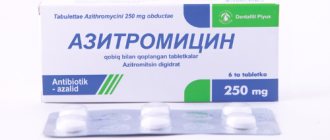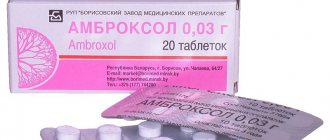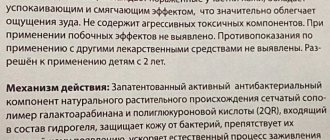Today in pharmacies you can find many antibiotics that have a different spectrum of effects. However, only a few of them can be used to treat children. The drug Azithromycin 250 belongs to such medications.
The antibiotic Azithromycin 250 can be used to treat children.
Release form and composition
The drug enters the pharmaceutical market in the form of gelatin capsules or tablets of 250 mg of the active ingredient (azithromycin).
The drug is sold in the form of gelatin capsules or tablets of 250 mg of the active ingredient (azithromycin).
Additional components: low molecular weight povidone, lactose, magnesium stearate, aerosil (colloidal silicon dioxide).
Capsules (tablets) are placed in plates of 6 or 10 pieces. There is 1 package in a cardboard box. In addition, the drug can be packaged in polymer bottles or glass jars of 6 or 10 pcs.
Terms of sale and storage
You can purchase Azithromycin at a pharmacy only after presenting a prescription from a doctor. The price of the medicine will depend on many factors, including the form of release, dosage, manufacturing company and others. Domestic drugs are cheaper (their price is from 30 rubles), while foreign ones are more expensive.
Azithromycin should be kept in a place where a small child cannot reach. Storage temperature – room temperature (up to 25°C). You cannot use a medicine that has expired (for Azithromycin it is 2 or 3 years, depending on the manufacturer and form of the drug). The suspension prepared from the powder form should not be stored for longer than five days.
Azithromycin in any form can be purchased at a pharmacy only with a pediatrician's prescription with the specified dosage and course of administration. When purchasing, you need to pay attention to the expiration date. Depending on the type of medicine and the manufacturer, the expiration date may vary.
Medicines should be stored away from the child in a dark and cool place (temperature no higher than 25 degrees). If the conditions are not met, the shelf life of the drug is reduced. It is advisable not to use this remedy for treatment.
Pharmacological properties
Pharmacodynamics
The active component of the drug is azalide and has a bacteriostatic effect. It forms bonds with ribosomal elements, inhibiting peptide translocase and protein synthesis in bacterial cells, preventing their reproduction and viability.
The drug is active against the following pathogenic microorganisms:
- gram-positive: Streptococcus agalactiae, Staphylococcus epidermidi, Streptococcus spp., Streptococcus pneumoniae, Streptococcus pyogenes;
- gram-negative: Neisseria gonorrhoeae, Gardnerella vaginalis, Legionella pneumophila, Moraxella catarrhalis, Bordetella parapertussis.
- a number of anaerobic microorganisms: Bacteroides bivius, Clostridium perfringens, Peptostreptococcus spp.;
- others: Treponema pallidum, Chlamydia pneumoniae, Borrelia burgdorferi, Mycoplasma pneumoniae, Mycobacterium avium complex, Ureaplasma urealyticum.
The medication is not active against gram-positive bacteria that are resistant to erythromycin.
The medication is not active against gram-positive bacteria that are resistant to erythromycin.
Pharmacokinetics
The medicine has a high degree of absorption. The maximum plasma concentration is reached in 2.5-3 hours.
In tissues and cells, the level of the active substance is 10-50 times higher than in blood plasma.
The ingredient easily overcomes the BBB and enters the skin, soft tissues, respiratory system, genitourinary organs and tissues, as well as the prostate gland. Cumulation of the substance is observed in lysosomes.
The half-life is from 14 to 20 hours. Excreted in bile and urine. Food reduces the highest plasma concentration of the substance by 52%.
The drug is excreted from the body with bile and urine.
Operating principle
Azithromycin for children (the instructions for use contain information about the effect of the drug on the body) is characterized by the speed of treatment of infection, which shortens the recovery time. After consuming the product, the maximum amount of the active substance is observed after 120-180 minutes.
Complete elimination occurs 6 days after administration (excreted in feces and 5% in urine). The last dose of the drug remains in the body for another 6-7 days. And all this time the therapeutic effect of the drug remains. Therefore, for treatment it is enough to take a single dose of the drug per day and a course of treatment of 3-5 days.
The acidic environment of the stomach does not affect the effectiveness of the drug, but food may slow down the effect. Azithromycin is localized in the site of inflammation (tissues, lungs, skin), the concentration of the drug in the blood is minimal. Therefore, the antibiotic does not cause severe harm to the body, but only acts on the infection.
Due to its direct effect, the product is highly effective. The active element does not allow bacteria to multiply and grow, and also disrupts their viability. The antibiotic has no effect on fungi and viruses.
Azithromycin belongs to the group of macrolides. Such antibiotics have a fairly wide range of effects on harmful bacteria. After entering the patient’s body, they are transported to the site of inflammation and penetrate both tissue barriers and cell walls.
In a moderate dose, Azithromycin can suppress the formation of proteins in bacterial cells, which slows down their reproduction. A high concentration of the drug has a bactericidal effect (destroys the pathogen).
Taking Azithromycin is effective for infection:
- Staphylococcus aureus.
- Staphylococcus epidermidis.
- Streptococci of group B and other groups.
- Pneumococcus.
- Pyogenic streptococcus.
- Haemophilus influenzae.
- Moraxella.
- Whooping cough stick.
- Parawhooping cough stick.
- Campylobacter.
- Legionella.
- Gonococcus.
- Gardnerella.
- Bacteroides.
- Peptostreptococcus.
- Clostridia.
- Chlamydia.
- Mycobacteria.
- Ureaplasma.
- Mycoplasma.
- Treponema pallidum.
- Borrelia.
Contraindications
The drug is not prescribed to patients weighing less than 45 kg, as they have difficulty selecting the dosage. However, in this case, you can use a suspension.
It is prohibited to take capsules for the following conditions and diseases:
- severe kidney and liver disorders;
- individual intolerance (hypersensitivity) to the drug.
The antibiotic is prescribed with caution for moderate pathologies of the kidneys and liver, arrhythmia and a tendency to it.
Overdose
If a child accidentally takes a very high dose of Azithromycin, it will result in vomiting, severe nausea, or diarrhea. There may also be temporary hearing loss. To help the baby, you should immediately rinse the stomach and consult a doctor to prescribe symptomatic treatment.
In case of accidental overdose of the drug, urgent gastric lavage is necessary, the child is given activated charcoal or polysorb. If the poisoning is not severe, then these procedures are sufficient. In case of a large overdose, it is necessary to call emergency help.
As a result of an increased dose of the drug, the child may experience temporary deafness. At the same time, diarrhea and nausea with vomit may be present. A malfunction in the digestive tract can lead to dehydration, so it is necessary to give the child more liquid, and, if necessary, saline solution.
How to use Azithromycin 250
Tablets and capsules are intended to be taken orally, 50-60 minutes before meals or 120-130 minutes after meals.
If a dose is missed, the next dose should be taken as soon as possible, and subsequent doses should be taken after 24 hours.
Dosage at different ages
Adult patients and children over 12 years of age are given doses of 500 mg of the drug once a day for 3 days.
For patients 6-12 years of age, dosages of Azithromycin are calculated at 10 mg per 1 kg of weight 1 time per day.
For patients 6-12 years of age, dosages are calculated at 10 mg per 1 kg of weight 1 time per day.
Lyme disease begins to be treated with a dose of 1 g on the first day, after which the amount of medication is reduced to 500 mg/day.
At what age is it allowed to take
Depending on the form of the drug, the age of the patient changes. The powder suspension is approved for use from 6 months. Capsules and tablets from 3 years. Because younger children may choke on the medicine. Injections with azithromycin can be given after 16 years of age. For small children (up to 3 years old), a single dose is calculated by the pediatrician based on the child’s weight.
Azithromycin is not used in the treatment of children under 6 months of age. If the child is already six months old, the doctor may prescribe such a medicine in the form of a suspension. Tablet form or Azithromycin capsules are given to older children who may swallow such drugs. The dosage is calculated based on the child's body weight. Azithromycin infusions are contraindicated before the age of 16.
special instructions
Can Azithromycin be given to children?
For children, dosages are calculated according to their body weight.
It is not advisable to use antibiotics in pregnant women.
Is Azithromycin possible during pregnancy and lactation?
It is not advisable to use an antibiotic in pregnant women unless the benefits outweigh the possible risks.
When prescribing an antibiotic drug, breastfeeding should be avoided.
For impaired renal function
The antibiotic is used with caution. In case of severe pathologies of the organ, it is not prescribed.
For liver dysfunction
For moderate disorders, the antibiotic is prescribed with caution. In severe cases, the use of the medication is prohibited.
In severe cases of liver pathologies, the use of the medication is prohibited.
Reviews
There are many positive reviews about the use of Azithromycin in the treatment of children. Mothers note that this antibiotic is very effective for bronchitis and pneumonia. It helps eliminate cough, reduce body temperature and quickly cope with the disease. It is also often used for otitis and sore throats, because these bacterial infections are very common in childhood.
The advantages of Azithromycin are the many dosage forms and the ease of use of the suspension for young children. All mothers like that the medicine is given only once a day, and the duration of treatment is short. Negative reviews of Azithromycin include complaints about the ineffectiveness of treatment (if the pathogen turns out to be resistant to the drug) and frequent side effects (allergies, headaches, nausea, and others).
Drug interactions
The antibiotic reacts with the following substances and drugs:
- antacids - reduce the plasma level of the active substance by 25-30%;
- Triazole, Indinavir, Cotrimoxazole, Cimetidine - there is a risk of a decrease in their effect;
- Cyclosporine, Digoxin - there is a possibility of reducing their absorption;
- Warfarin – it is necessary to monitor the prothrombin period with such a combination;
- Terfenadine – arrhythmia appears;
- Rifabutin – increases the risk of leukopenia and neutropenia;
- ergot alkaloids – ergotism (poisoning) develops.
Azithromycin suspension
- Azitrox;
- Sumamed;
- Ecomed;
- Chemomycin.
Average price online*, 273 rub.
(200mg/5ml suspension) Where to buy:
Instructions for use
Azithromycin is a macrolide-azalide antibiotic. It has a wide spectrum of action. The pediatric form is a powder for the preparation of an oral suspension.
Indications
The drug is prescribed for infectious and inflammatory diseases caused by bacteria sensitive to the drug:
Prescribing medication for women expecting a baby and breastfeeding
An antibiotic is prescribed to pregnant patients for health reasons, if the benefit to the woman is greater than the potential harm to the child.
The active substance is secreted by the mammary glands, so it is advisable to switch the infant to artificial feeding during therapy.
Overdose
If the recommended dosage is exceeded, the victim may experience the following signs of poisoning:
- reversible deafness;
- diarrhea;
- nausea;
- vomit.
There is no antidote; therapy is aimed at eliminating signs of intoxication.
Side effects
While taking an antibiotic, undesirable effects may develop such as:
- indigestion, complete refusal to eat, pseudomembranous enterocolitis, nausea, vomiting, stool disorders, excessive gas formation, discoloration of the tongue, abdominal pain, intrahepatic cholestatic syndrome and other liver pathologies, including the death of hepatocytes, which can cause the death of the patient, gastritis;
- sensation of your own heartbeat, increased heart rate, arrhythmia, chest pain;
- allergic reactions, in some cases fatal;
- vertigo, asthenia, sleep disturbance, hyperactivity, excitability, aggressiveness, cephalgia, in the treatment of otitis media;
- disorders of the senses (disorders of hearing, smell, taste, conjunctivitis);
- joint pain;
- candidiasis;
- renal failure;
- decreased levels of platelets and neutrophils, increased concentration of eosinophils;
- tubulointerstitial nephritis;
- photosensitivity.
Pharmacology and pharmacokinetics
Azithromycin reacts with the large subunit of ribosomes, blocks the enzyme peptide translocase, which is responsible for the production of bacterial protein, which leads to the growth and reproduction of the pathogen being suspended.
In large dosages, the antibiotic causes the death of bacteria; it is effective against pathogenic agents localized inside and outside the cell.
The active substance is active against the following:
Staphylococcus aureus
- gram-positive bacteria: Staphylococcus aureus, streptococci;
- gram-negative microorganisms: influenza bacillus, Moraxella catarrhalis, pertussis bacillus, Legionella pneumophila, gonococcus, Gardnerella vaginalis;
- anaerobic bacteria: clostridium perfringens;
- chlamydia, ureaplasma, treponema pallidum, mycoplasma.
The active substance is well absorbed from the gastrointestinal tract and quickly penetrates tissues and organs. It easily migrates through internal barriers, while at the site of infection its concentration is higher than in healthy tissues, and as inflammation increases, it becomes even higher.
After the dose taken, the therapeutic concentration in the body is observed for another 5-7 days. The antibiotic is metabolized in the liver. 50% of the dose taken is excreted through the intestines and 6% through the kidneys.
Terms of purchase and storage
You can purchase the suspension with a doctor's prescription. The medicine is stored in a place where children cannot reach it, at a temperature of maximum 25⁰. The finished suspension is stored for no more than 5 days at room temperature.
Analogs
A similar active ingredient is contained in the following products:
- Sumamed;
- Azimicin;
- Chemomycin;
- Zithrocin;
- Ecomed.
An analogue of Azithromycin 250 is the drug Sumamed.
The following drugs have a similar principle of action:
- Rovamycin;
- Macropen;
- Lecoclair;
- Arvicin;
- Fromilid;
- Oleandomycin;
- Erythromycin.
Instructions for use
Azithromycin is a semisynthetic antibiotic with a bacteriostatic mechanism of action. Accumulating in the human body, it begins to act bactericidal, that is, destroy the cells of bacteria that cause the disease. The drug is available in several forms and in various dosages:
- tablets of 250 and 500 mg;
- capsules of 250 and 500 mg;
- suspension of 100 and 200 mg per 5 ml;
- injection.
The suspension is intended for the treatment of children under 12 years of age. It is available in powder form for home preparation. Each package contains a bottle of medicinal powder, a plastic syringe for administering medication to patients with difficulty swallowing and children who cannot drink solid medications, a 5 ml measuring spoon and instructions for using Azithromycin suspension for children.
The pediatrician prescribes Azithromycin for children for sore throat, tonsillitis, bronchitis, pneumonia and a number of other common diseases. The dosage is chosen based on the child’s weight. Children weighing over 45 kg are prescribed capsules or tablets with a dosage of 250 mg, and up to 45 kg - syrup.
Dosage of the drug according to the patient's weight.
Weight (in kg)
Dosage in solution 200 mg per 5 ml (in ml)
In case of a serious illness, the doctor increases the dosage and chooses a different regimen for taking the medicine (stepwise, longer and with larger doses of the medicine). Duration of therapy is from 3 to 5 days.
How to take the drug. The suspension for children, like other forms, is taken once a day 1 hour before meals or 2 hours after. It is better to take the medicine at the same time. If an appointment is missed, doctors recommend resuming the missed appointment and repeating it after 24 hours.
- To prepare the syrup, boiled water at room temperature is poured into a bottle with powder up to the mark indicated on the bottle and the solution is shaken.
- It is recommended to use the suspension within 5 days from the date of preparation.
- Shake the prepared preparation before each use.
- After use, the spoon or syringe is washed and wiped dry.
- The drug is washed down with water, rinsing the mouth from any remaining medication.
- For the correct dosage and ease of administration, children under 3 years of age are administered the drug with a special measuring syringe.
Instructions for use
It is known that small children should not be allowed to swallow a pill; they often do not know how or do not want to do it. Some can learn at 2.5 years, others refuse at 5.
Fortunately, in most cases, medications for children are produced in the form of a suspension, one of them is Azithromycin. An antibiotic that has proven itself in the treatment of respiratory tracts.
Important! Do not prescribe antibiotics yourself, consult your doctor
Indications
All indications for the drug are given:
- Angina;
- Bronchitis;
- Laryngitis;
- Otitis;
- Pneumonia;
- Sinusitis;
- Tonsillitis;
- Pharyngitis;
- Unspecified infections of the upper respiratory tract and ENT organs;
- Scarlet fever;
- Impetigo;
- Erysipelas;
- Infectious dermatoses, infections of the skin and soft tissues;
- Gonococcal and non-gonococcal urethritis;
- Cervicitis;
- Borreliosis (Lyme disease), only in the initial stage;
- Gastrointestinal diseases caused by Helicobacter pylori (only as part of combination therapy);
- As well as other infectious diseases caused by microorganisms sensitive to this drug.
1. Open the bottle and add boiled, cooled water. There is a special mark on the bottle to which you need to add water, marked with a red arrow in the figure.
2. Shake
3. Done!
After each dose, the measuring syringe and spoon should be washed.
It is customary to prescribe a suspension of 100 mg/5 ml for children from 6 months to one year, for those older, 200 mg/ml is prescribed. The general principle for calculating the dosage is 10 mg per kilogram of the child’s weight once a day.
The standard duration of treatment is from 3 to 5 days, determined by the doctor.
| Child's weight in kg | Suspension 100 mg/5 ml | Suspension 200/5 ml |
| 5 | 2.5 ml (50 mg antibiotic) | — |
| 6 | 3 ml (60 mg) | — |
| 7 | 3.5 ml (70 mg) | — |
| 8 | 4 ml (80 mg) | — |
| 9 | 4.5 ml (90 mg) | — |
| 10—14 | 5 ml (100 mg) | 2.5 ml |
| 15—25 | 10 ml (200 mg) | 5 ml |
| 26—35 | 15 ml (300 mg) | 7.5 ml |
| 36—45 | 20 ml (400 mg) | 10 ml |
| Over 45 | The antibiotic is prescribed in a dosage for adults |
Contraindications
- Age up to 6 months;
- Hypersensitivity to the components of the drug and to other macrolide antibiotics;
- Renal failure (provided that creatinine clearance is less than 40 ml/min);
- Liver dysfunction (class C on the Child–Pugh scale).
FDA category of effect on the fetus is B (studies have not been conducted in humans).
Breastfeeding should be discontinued during treatment.
The following symptoms are possible: nausea, vomiting, loose stools, temporary hearing loss.
Side effects
Allergy sufferers and people with liver problems should be especially careful, otherwise the side effects differ little from other antibiotics.
Children may experience decreased appetite, gastritis, and candidomycosis of the oral mucosa.
General effects: abdominal pain, diarrhea, jaundice, constipation, change in tongue color, flatulence, pancreatitis, increased ALT and AST activity, bilirubin levels, pseudomembranous colitis, vomiting, nausea, cholestasis, liver failure (in extremely rare cases, liver necrosis and fatal, check your liver before taking).
Compound
Active ingredient: azithromycin dihydrate – 100 mg in terms of azithromycin;
Excipients: flavors: strawberry, mint, apple, cinnamon; anhydrous sodium carbonate, sodium benzoate, titanium dioxide, xanthan gum, colloidal silicon dioxide, crospovidone, lactulose, sugar.
The spectrum of action includes gram-positive and gram-negative microorganisms, anaerobes, chlamydia, mycobacteria, mycoplasmas, ureaplasmas and spirochetes.
The drug is quickly absorbed into the blood, bioavailability is 37%, Cmax (0.4 mg/l) is created after 2–3 hours. A stable plasma level is achieved after 5–7 days. Easily passes histohematic barriers and enters tissues. In the liver it is demethylated, losing activity. Excreted in bile and urine.











